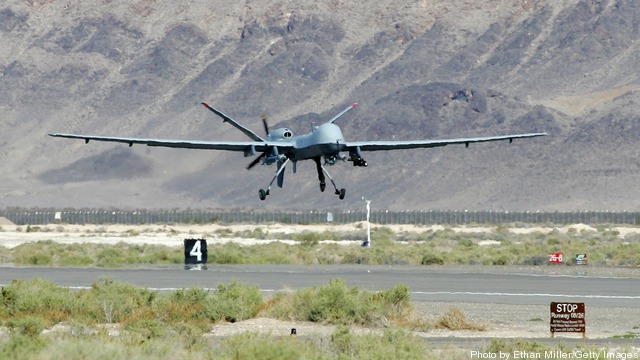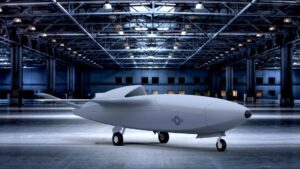
An MQ-9 Reaper takes off at Creech Air Force Base.
WASHINGTON: The Air Force plans to develop a family of highly-survivable drones for multiple missions to replace the MQ-9 — but rather than the Reaper’s traditional ground-attack role, the service’s top priority seems to be counter-air capabilities.
“At first glance it looks like a complete reverse of the counterterrorist air-to-mud mission for MQ-9, a battle-proven drone that can’t survive hot air defenses,” said Rebecca Grant, founder of IRIS Independent Research.
This may well raise hackles among Combatant Command leaders — and many in Congress — who are wedded to the Reaper for use in ongoing operations such as in Afghanistan and the killing of high-value targets. Congress blocked Air Force plans to stop production of the MQ-9 by prime contractor General Atomics in 2021, adding 16 aircraft to its budget plans. Air Force Chief of Staff Gen. CQ Brown admitted last month that the service “can’t just walk away” from the MQ-9 because of its popularity with commanders.
Mark Gunzinger, director of future projects at the Mitchell Institute, said in an email that the new effort could well spark concerns among MQ-9 supporters. “But it shouldn’t,” he said.
First, he explained that “Reapers will be in the force for a long time.” Second, “the family of UAVs the Air Force apparently wants to procure will expand — not contract — the mission capabilities of its UAV force and threat environments it will operate in.” And finally, “I believe the Air Force intends to grow its overall UAV capacity over time, not reduce it. UAVs—including attritable systems—are force multipliers in many regards.”
Likewise, Grant said the shift makes sense particularly when looking at the Pacific theater and competition with China.
“The peer battle in the Pacific is so stressing that ACC [Air Combat Command] wants every missile carrier and comm relay node it can put in the air. They might deploy P-51 Mustangs if the museums would give them up,” she said. “Then there is targeting for those Army long-range fires set to dot the
Pacific – that will take lots of combat air patrols.”
The new Air Force approach effectively moots the plan put forward last June, known as MQ-Next.That was a family of uninhabited aerial vehicles focused solely on the hunter/killer mission set — that is, intelligence, surveillance and reconnaissance (ISR) and strike. The first Air Force Reaper replacement program, called MQ-X, was terminated in 2012.
The “Next Generation (Next-Gen) Multi-Role Unmanned Aerial System (UAS) Family-of-Systems (FoS)” effort “is more than MQ-X/Next, this is a new effort as the expanded mission now goes beyond a strict MQ-9 replacement,” a spokesperson for the Air Force Life Cycle Management Center (AFLCMC) said in an email. “This endeavor serves to explore concepts that address capability gaps of legacy platforms against increasingly sophisticated threats in denied, contested, and highly contested environments.”
AFLCMC is managing the emerging program, and issued an update March 23 to its original March 5 request for information (RFI).
With the US military’s pivot toward great power competition, Air Force leaders have been particularly worried about the ever-increasing threat from sophisticated air defenses, including Russia, China, and even Iran, Yemen and Libya. (Iran, for example, in 2019 shot down a Reaper over Yemen.)
“The reality is is that the amount of permitted airspace around the globe is shrinking, and more and more air spaces is becoming more and more contested as time moves forward,” Jacob Johnson, ISR/UAS director at Lockheed Martin’s Skunk Works, said in an interview.
Thus, the new drone family concept not only seeks to address a range of missions, but also develop a variety of platform types that the AFLCMC RFI describes as: “Attritable, Expendable, Survivable, and reusable.” (The RFI helpfully explains that the service intends to release an explanation of the concepts of operation behind those terms, and the differences between them, when an RFP is released.)
“Future Next-Gen Multi-Role UAS FoS technologies must hold a different role than they do today and address capabilities beyond traditional UAS mission sets, such as air-to-air, base defense, electronic warfare, moving target indicator (air and ground) capabilities, and be designed for native integration into JADC2 [Joint All Domain Command and Control]. The plan for this approach includes investment in military-specific systems, as well as the commercial market,” the RFI states.
AFLCMC is developing a plan to roll out drone variants over time, the spokesperson explained.
First priorities: air domain awareness; protecting crewed aircraft; autonomy
“Airborne domain awareness and High-Value Airborne Asset Protection (HVAAP) are the first set of mission requirements being fed into the pipeline; however, communications is also critical to the mission spaces mentioned above,” the spokesperson said. “This aligns with the RFI’s request for resilient communication suites to support data sharing, integration, and secure processing.”
The RFI describes airborne domain awareness as including “airborne moving target indication,” that uses “sensors or sensor networks that provide early warning and fire control quality track/ID of enemy air operations in highly contested and contested environments.”
“Air domain awareness is a foundational capability that supports a wide range of security and defense activities, including protection of high value airborne assets,” said Chris Pehrson, vice president of special programs at General Atomics Aeronautical Systems (GA-ASI), in an email. “A persistent UAS, potentially working in conjunction with other manned or unmanned platforms, can create a sanctuary of safe airspace where tankers, command & control aircraft, or other less survivable aircraft can operate with impunity.”
HVAAP is defined by the RFI as: “Sustain defensive counterair capabilities to protect HVAA from long-range enemy fighters and other kinetic and non-kinetic threats.” It involves, the RFI states, “Next generation platform agnostic weapons, sensors, electronic warfare, directed energy, and other capabilities required for HVAAP.” The RFI adds that this drone variant should also include “solutions for Offensive Counter Air (OCA), Defensive Counter Air (DCA), and Red Air.”
The Reaper, by contrast, has primarily been used for striking terrorist enclaves and other ground targets during US contingency operations abroad. It was tested with an air-to-air missile only in 2017, as first reported by colleague Oriana Pawlyk.
“Never thought I’d see a new MQ-9 replacement with a role the offensive air battle but times have changed,” Grant said. “If the space network goes down it will be over to the unmanned planes to improvise. Add to that an emerging need to plan for a homeland air defense mission over the US, and I can see why this RFI is out there.”

Skyborg, AFRL artist’s image
The Air Force also is keenly interested in integrating autonomous capabilities into the new drone family. Air Force Research Laboratory (AFRL) for some years has been pursuing autonomous drones, including under the high-priority Skyborg program. The new effort “plans to leverage the Department of the Air Force’s work on UAS autonomy under the Skyborg program, but may expand along different areas of interest. The two efforts will complement each other,” the AFLCMC spokesperson explained.
New effort opens a wide competition
In an annex to the RFI responding to industry questions, AFLCMC stresses that the current solicitation is aimed solely at market research rather than formal industry proposals (via an RFP), and thus is not yet opening a program of record.
“The Next_Gen_Multi_Role_UAS is not a solicitation; it is a sources sought Request for Information (RFI). This is a follow-on RFI from the previous RFI released in June 2020. At this time, the Government does not have an anticipated date for RFP release,” the Q&A document states. “The Air Force is in the early stages of requirements and acquisition strategy development that will continue throughout FY 2021.”
The Q&A sheet goes on to explain: “There is no incumbent contract for the work specified in this RFI. This RFI is to support the market research of a new program, which is not yet a Program of Record.” This arguably opens the door wide for a number of industry contenders beyond General Atomics.
Johnson said that Lockheed Martin intends to respond to the RFI, and is focused on three key aspects of the solicitation: survivability; open systems architectures that would allow switching out types of payload packages on any one drone body as well as ease updating with new capabilities; and digital design/engineering to push down costs not just for the drones themselves, but also managing sustainment over time.
Open systems architectures and non-proprietary software are key to ensuring weapon systems can “keep pace with our adversaries,” he stressed. “You can change out waveforms; you can change out sensor fusion algorithms; you can change out AI systems with software upgrades.”
Skunk Works has been working on “a family of UAS, starting with common airframes,” Johnson said. “We have a tremendous amount of commonality — down to bulkhead, down to smaller levels — amongst our airframes; common mission systems all built on this open system architecture concept; and then with digital engineering and the digital thread really embedded in everything.”
With regard to the RFI, he noted that two airframes Lockheed Martin might put forward are: the platform being developed for DARPA’s LongShot effort to design a kind of ‘mothership’ missile that would carry multiple smaller air-to-air missiles; and the smaller Stalker that observers believe was originally designed for Special Operations Command. (Northrop Grumman and General Atomics also are involved in the LongShot program.)
General Atomics is approaching the new Air Force effort with a keen eye on the “two opposing dynamics in the current national security environment” of a need for investment and pressure to cut costs, Pehrson said. This means that weapons development can’t be about “inventing a silver bullet to solve every problem, but rather about leveraging existing capabilities and focusing investment on critical capabilities that enable the future force,” he explained.
Thus, “General Atomics envisions a future force comprised of families of systems — manned, unmanned and autonomous — that complement, augment and interoperate to deliver capabilities that are truly greater than the sum of its parts,” Pehrson elaborated. GA-ASI is “excited” about the Air Force’s FoS concept because “it presents an opportunity to think differently about how we approach existing problems, how we employ existing systems, and how we maintain advantage over current and future threats,” he added.
Boeing likewise plans to respond to the RFI, said spokesperson Ashlee Erwin in an email. However, the company “cannot share details at this time.”
Taking aim: Army leaders ponder mix of precision munitions vs conventional
Three four-star US Army generals this week weighed in with their opinions about finding the right balance between conventional and high-tech munitions – but the answers aren’t easy.


























